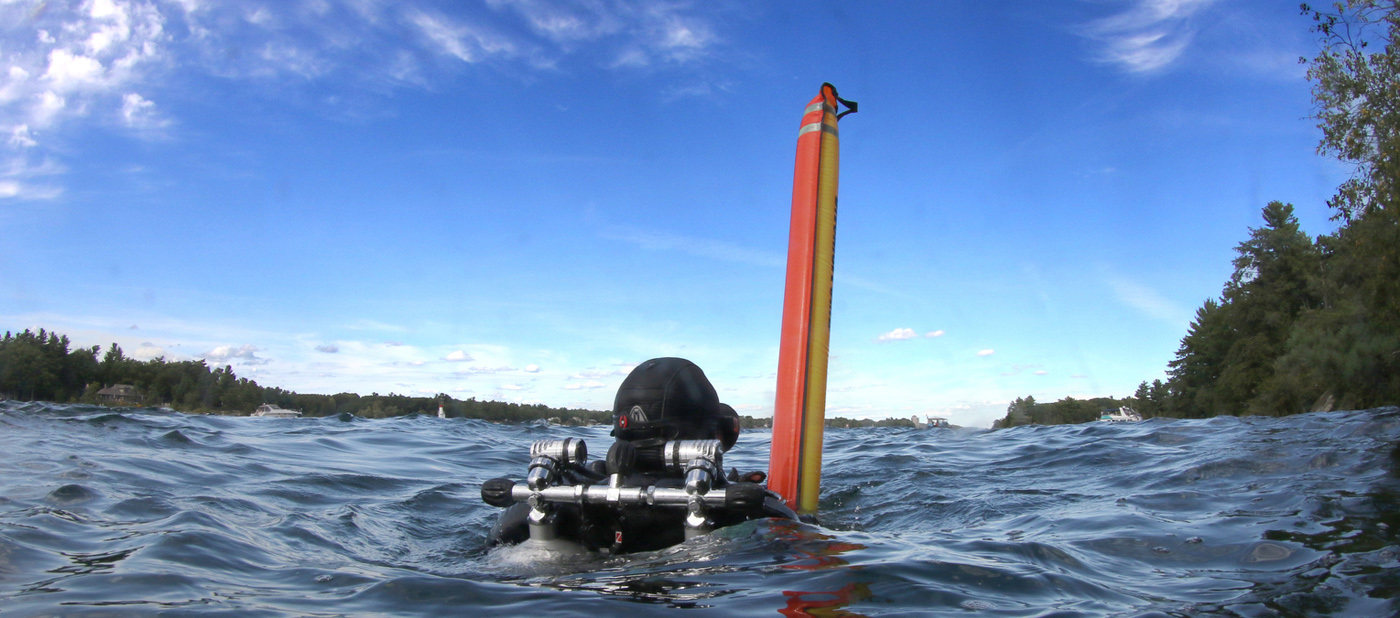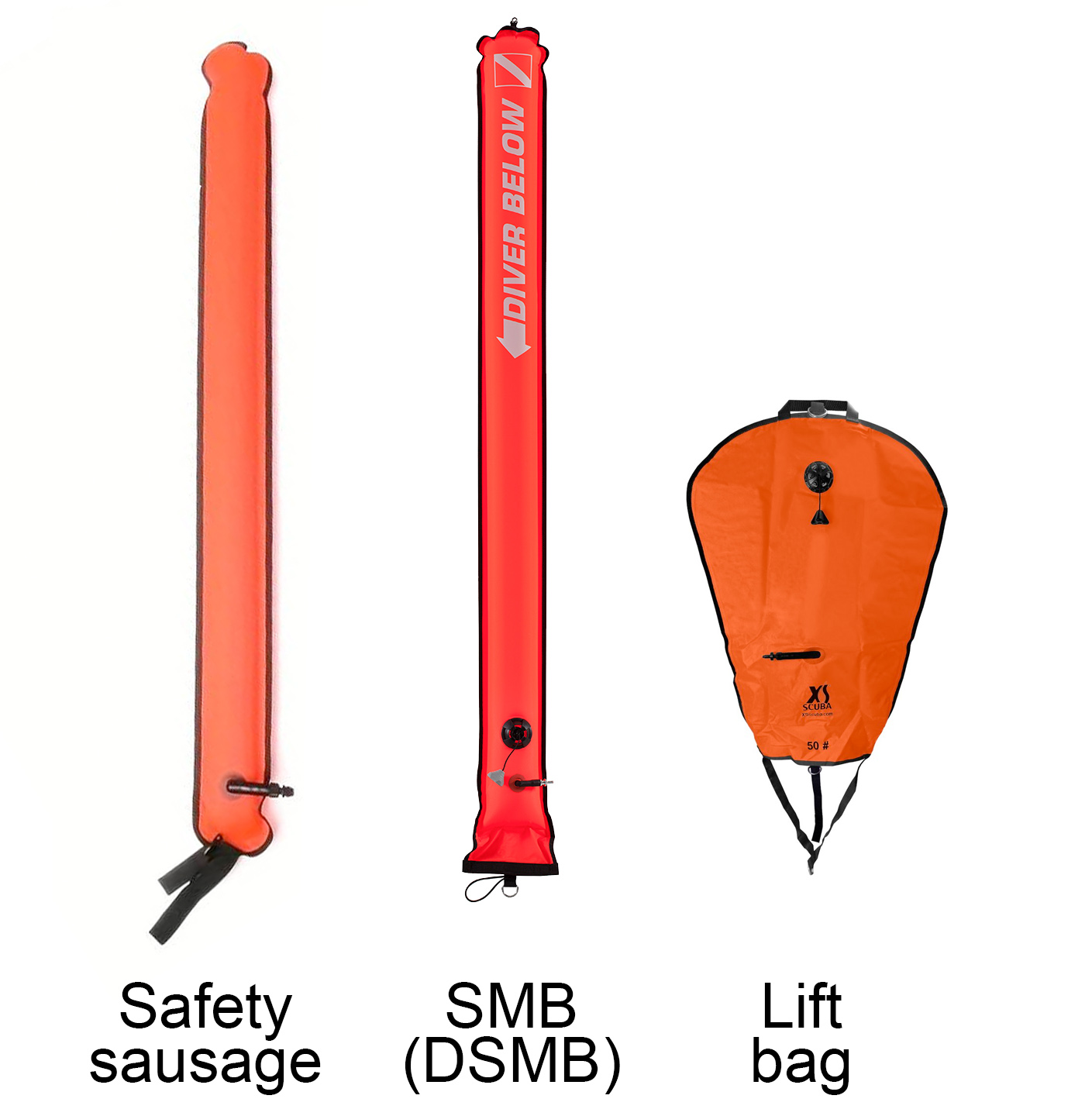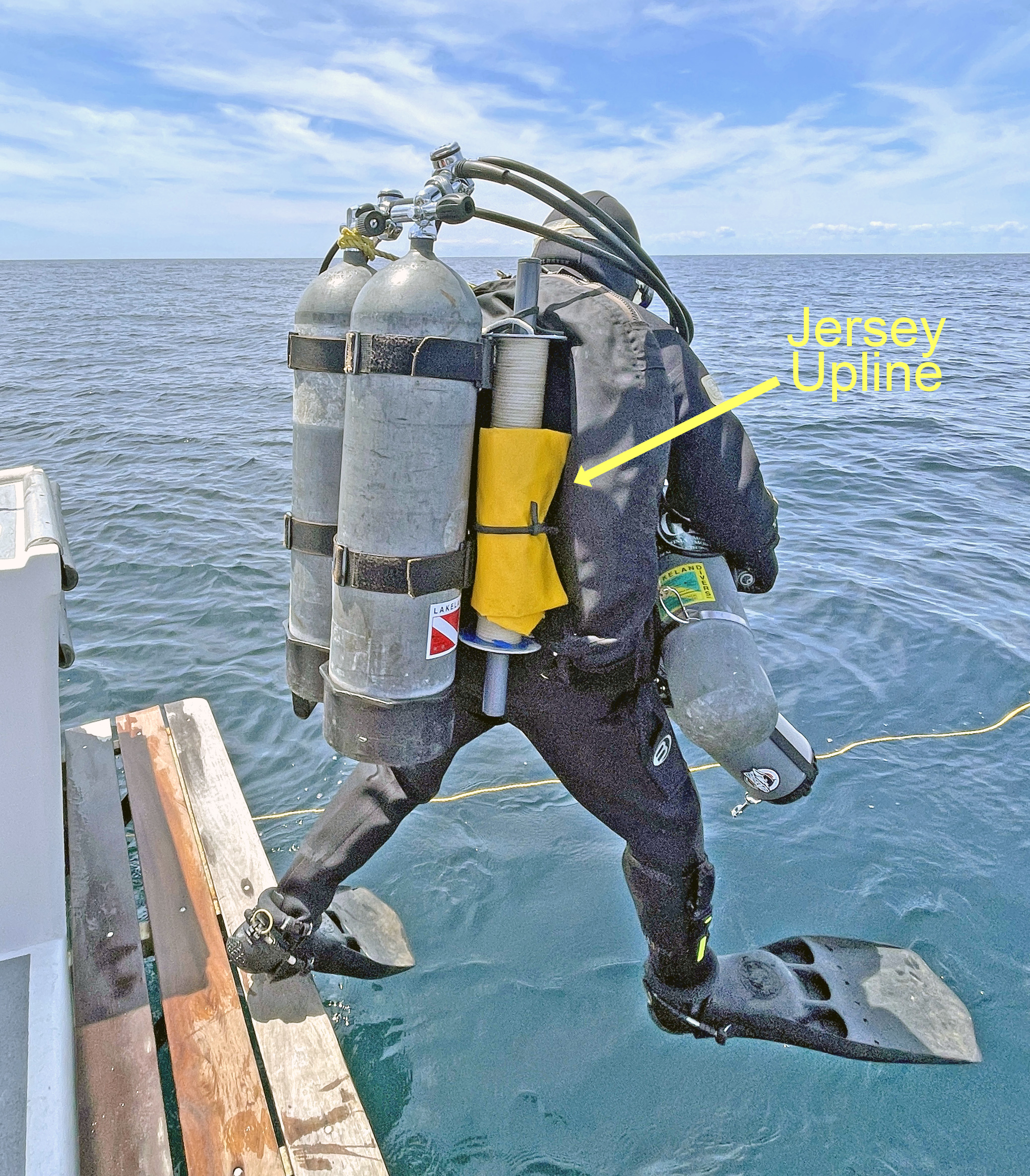Surface Marker Buoys

There are three terms describing inflatable bags used in scuba diving - safety sausage, SMB (surface marker buoy) and lift bag. Technically, what most people refer to as a "safety sausage" is really an SMB, and what most people refer to as an SMB is really a DSMB (delayed surface marker buoy). But I'm going to use the term SMB in this discussion as this is - incorrectly but near universally - used by divers in our area.
A safety sausage is the simplest of the three, and is generally a long inflatable tube that is deployed after a diver has surfaced to make them more visible in open water. This can help a dive boat see them and pick them up, especially if there is poor lighting or large waves. Generally, the taller the better (some are six feet long), but safety sausages tend to be fairly small to be carried easily when rolled up.
An SMB is different from a safety sausage because it is designed to be inflated underwater and sent to the surface on a line from a reel or a spool. In order to do this, it has an overpressure valve that lets gas escape as it surfaces. Without this, it could burst as the gas inside expands, especially if filled at a significant depth. In practice, there is really no reason to buy a safety sausage without an overpressure valve. Theoretically they would be smaller and cheaper, but every diver should learn how to deploy an SMB from depth (for reasons discussed below), and you can get fairly small, cheap and compact SMBs these days. There is no need to limit the use of this device to the surface.
A lift bag is generally a short, squat bag which does not stick up very far from the surface of the water, but which has a larger volume than the typical SMB. It is meant for lifting heavy things off the bottom. While you can use your BC to assist with lifting something heavy, this is a much safer method. Using your BC means that if you drop the item on ascent you will not only lose it, but you will suddenly become very buoyant and may have an uncontrolled ascent.
So when would you deploy an SMB from depth (also known as "shooting a bag")? In areas where drift diving is common, a diver will deploy this at the end of the dive to let the dive boat follow them more easily for a pickup. In the NYC area, however, drift diving is rarely done, and deploying an SMB is generally a sign of a problem. If the dive boat sees an SMB hit the surface, they will react accordingly and may even send a diver down to see if assistance is needed. Conversely, dive crews seeing a lift bag on the surface will assume that you are recovering a heavy artifact, and may assume that you are not in need of assistance. This is why it's important to not use an SMB as a lift bag or vice versa.
The most common reason for sending up an SMB is when a diver gets lost on a wreck, or separated from the dive site and can't find the anchor line to get back to the boat. This is unfortunately not uncommon with inexperienced divers in poor visibility. In this case, especially if there is current, it makes sense to deploy the SMB. This will let the dive boat know that you are ascending away from the anchor line. You should do everything possible to avoid this, but it is preferable to a free ascent where you may be drifting rapidly away from the dive boat. If you were to drift away, even if the boat crew were to see you on the surface, they may not be able to go after you, especially if there are other divers in the water. With any significant decompression obligation, the time of ascent would be much longer and you would almost certainly surface out of sight of the dive boat. With low gas reserves, obviously ascending takes priority over everything else, but it is always better to go up the anchor line, or another line secured to the bottom if you can't find the anchor line in time.

The quickest and simplest way to use an SMB for an ascent away from the anchor line would be to deploy it from the bottom, then secure the line to the wreck or some other fixed object, and then use this line as a new ascent line. In the early days of local wreck diving many divers carried a "Jersey upline", which was a large spool stowed on the diver's back between or beside the double tanks. It was filled with heavy sisal line. The line was tied to the wreck, the SMB was deployed, and the diver ascended to the surface. Once the boat had made the pickup, the SMB was removed and the line left in place. Since it was biodegradable, it would soon break down. This material was not chosen for environmental reasons, but rather so as not to leave line on the wreck which could be an entrapment risk for future divers.
These days, divers carry some sort of cave line on reels or spools. This line is strong, and much thinner and lighter than the sisal, which means that you can carry hundreds of feet of line in a relatively compact package. However, it is not biodegradable, usually made from braided nylon, Dacron (polyethylene), or other similar material. So some attempt must be made to avoid leaving it on the wreck. In a true emergency, this may not be possible, but hopefully the diver will try to recover the lost line on a future dive.
There is a way of making an emergency ascent line that is recoverable from the surface, if you have plenty of line and if you are on a fairly shallow wreck. By looping your line around a horizontal fixed point (like a handrail or ladder), you can send the SMB to the surface on one end of the line, and then ascend by passing your reel or spool to the other side of the attachment point, and unreeling line as you go up. On the surface, the line will keep you from drifting. Once you are reunited with the dive boat, you can recover your SMB, detach the line and then pull it back on your reel as it is pulled around the attachment point. This method requires enough line to go from the bottom to the surface twice, plus extra for the "scope" of the line - the angle at which you are pulled by current.
Whichever method you choose to inflate your SMB, it is crucial to practice this in shallow, controlled situations. Launching an SMB from depth is potentially dangerous - if you become tangled in it, it may pull you to the surface in an uncontrolled ascent. However you do this, you must be able to release it if necessary, even if that means losing your line and the SMB. This why we carry redundant equipment - "three is two, two is one, one is none".
When practicing these techniques, it's a good idea to have a buddy standing by with something to cut the line in an emergency. The best thing for this is a Trilobite line cutter or EMS style trauma shears. You do NOT want your buddy frantically coming at you swinging a knife in an emergency!
Different SMB designs allow for different inflation methods. Most of them have a standard Schraeder valve, similar to the low pressure inflator hose attachment on a BC. This has a spring loaded end, that you can compress and inflate orally (which is hard to do under water). You can also disconnect the inflator hose from your BC (or dry suit) and connect it to this valve to inflate the bag. Caution should be observed when doing this, however. You must be sure that the valve and line are in good condition and lubricated appropriately, or they may stick together, dragging you up (especially since this method inflates the SMB very rapidly).
Other SMBs have an open bottom, which lets you fill them either by purging a regulator into the opening or by catching exhaled gas. A completely open bottom is rarely used, since it will deflate once the bag reaches the surface. Most of these types of SMBs have some sort of baffle that will let gas flow in but not out while underwater. The advantage of this method is that it is a lot quicker than disconnecting a hose from your BC or drysuit and then reconnecting it later. The disadvantages are that it requires you to be fairly close to the SMB, which risks entanglement in the line (unless you are using a long primary hose). Also, some divers avoid purging a regulator at depth, especially in cold water, as a free flow may result. The exhaled gas trapping method avoids this problem, but it requires you to put your head VERY close to the line and SMB, it can be hard to master, and it is a relatively slow fill.
One other method is to use a separate dedicated low pressure line from your regulator (or possibly from a pony bottle). This can either have the standard Schrader connection or be fitted with a nozzle for SMBs with an open bottom / baffle design. This is very quick and easy, but it does add another hose and a failure point for potential gas loss.
Remember, you don't need to fully inflate the bag at depth, since the gas will expand as the bag rises. But there should be enough gas so that the tube will stand high on the surface with a little downward tension, making it more visible to the boat crew.
Some divers keep an SMB and spool rigged together for quicker deployment. Many technical divers keep them separate, as it is fairly easy to connect them when needed. This also means that you can have more line available by using a reel, and you can carry a backup SMB for redundancy. It is best to loop the line through the loop at the end of the SMB rather than relying on a bolt snap or double ender clip to connect them. While this hardware makes it somewhat quicker to connect, they can fail on ascent.
Divers using typical warm water recreational gear configurations may not have many places to stow the SMB and line. Since most divers in the NYC area are using dry suits, pockets are common places to store a rolled SMB. Another good idea is either a tail pouch or a backplate pouch - both of these keep the SMB out of the way until needed, but are easy to use. Simply clipping an SMB off to your BC makes it more likely to unravel during the dive; this is rarely done by experienced NYC area divers.
In some locations, boat crews will differentiate between colors of SMBs, with orange and yellow having different implications. This is not common in our area. Most divers carry two bags for redundancy, in case one is lost or nonfunctional at depth. With a color code, a diver would have to carry four bags for true redundancy. Furthermore, since these codes are far from universal, you would run the risk of a communications failure if the diver and the crew were trained differently.
Many local divers put their initials on the top of the bag with a permanent marker. This can be helpful for crews trying to figure out who is attached to a surfacing bag, which may be relevant for complex dives with different teams at different stages of decompression.
Remember, whatever configuration you end up with, practice deploying it until you can do it easily in a real emergency. Start in a pool, and then in controlled conditions like a quarry. Do NOT practice on a boat dive unless you have informed the crew of your intentions first!
